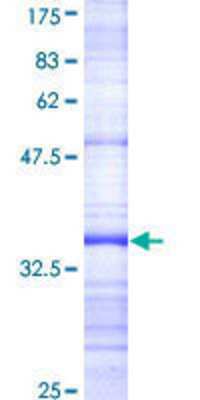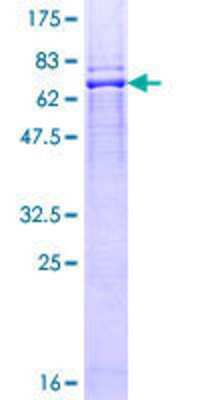BFAR Products
BAR (bifunctional apoptosis regulator) is a multidomain protein that was originally identified as an inhibitor of Bax-induced apoptosis (Zhang et al, 2000). Apoptosis induction can be divided up into two major pathways, extrinsic and intrinsic. The extrinsic pathway is represented by death receptor signaling and the intrinsic pathway depends on mitochondrial events. BAR is in anchored in intracellular membranes and is thought to be a scaffold protein that may bridge components of both extrinsic and intrinsic apoptosis pathways through its antiapoptotic domains: 1. BAR contains a DED (death effector domain)-like protein interaction domain that suppresses death receptor apoptosis signaling pathways. Death receptors such as the TNF (tumor necrosis factor)-family contain protein interaction domains called DD (death domains) in their cytosolic regions. DD-containing TNF receptor family members such as Fas aggregate upon binding ligand and bind to an adaptor protein FADD which contains both DD and DED domains. The Fas/FADD complexes bind to the caspase family members such as 8 and 10 which contain DEDs in their N-terminal prodomain. This is followed by proteolytic processing and caspase activation, thereby initiating a signal transduction cascade leading to activation of downstream effector caspases, substrate cleavage, and ultimate cell death. DED-containing antiapoptotic proteins like BAR function as transdominant apoptosis inhibitors by competing for binding to the DED domains of proapoptotic proteins like Fadd, caspase-8 and caspase-10, thereby preventing assembly of functional death-inducing complexes and hence activation of downstream apoptosis signaling cascades. 2. BAR also contains a domain that mediates interactions with Bcl-2 family proteins and that is required for suppression of Bax-induced cell death in yeast and mammalian cells. Although the physiological functions of BAR remain to be elucidated. BAR is highly expressed in the brain and expression patterns as well as functional data with neuronal cell lines suggest that BAR is involved in regulating neuronal survival (Roth et al. 2003). Additionally, subcellular localization studies indicate that BAR predominantly localizes to the endoplasmic reticulum (ER), irrespective of cell type. Bcl-2 family proteins also localize to the ER. There is important crosstalk between the ER and mitochondria in the execution of cell death. It is thought that both BAR and Bcl-2 proteins play a role in regulating cell death/apoptosis induced by ER stress. Dysregulation of ER homeostasis and apoptosis is thought to be involved in the pathogenesis of some human neuronal diseases, including Alzheimer's, Parkinson's, polyglutamine diseases, nueronal storage diseases, prion dieases, as well as acute neurodegeration from brain trauma (reviewed in Lindholm et al, 2006). Since BAR is normally widely expressed in the brain, it may have a cytoprotective function in helping neurons to survive for the entire lifetime of the organism by playing a central role in inhibiting ER initiated apoptosis.
Show More
8 results for "BFAR" in Products
8 results for "BFAR" in Products
BFAR Products
BAR (bifunctional apoptosis regulator) is a multidomain protein that was originally identified as an inhibitor of Bax-induced apoptosis (Zhang et al, 2000). Apoptosis induction can be divided up into two major pathways, extrinsic and intrinsic. The extrinsic pathway is represented by death receptor signaling and the intrinsic pathway depends on mitochondrial events. BAR is in anchored in intracellular membranes and is thought to be a scaffold protein that may bridge components of both extrinsic and intrinsic apoptosis pathways through its antiapoptotic domains: 1. BAR contains a DED (death effector domain)-like protein interaction domain that suppresses death receptor apoptosis signaling pathways. Death receptors such as the TNF (tumor necrosis factor)-family contain protein interaction domains called DD (death domains) in their cytosolic regions. DD-containing TNF receptor family members such as Fas aggregate upon binding ligand and bind to an adaptor protein FADD which contains both DD and DED domains. The Fas/FADD complexes bind to the caspase family members such as 8 and 10 which contain DEDs in their N-terminal prodomain. This is followed by proteolytic processing and caspase activation, thereby initiating a signal transduction cascade leading to activation of downstream effector caspases, substrate cleavage, and ultimate cell death. DED-containing antiapoptotic proteins like BAR function as transdominant apoptosis inhibitors by competing for binding to the DED domains of proapoptotic proteins like Fadd, caspase-8 and caspase-10, thereby preventing assembly of functional death-inducing complexes and hence activation of downstream apoptosis signaling cascades. 2. BAR also contains a domain that mediates interactions with Bcl-2 family proteins and that is required for suppression of Bax-induced cell death in yeast and mammalian cells. Although the physiological functions of BAR remain to be elucidated. BAR is highly expressed in the brain and expression patterns as well as functional data with neuronal cell lines suggest that BAR is involved in regulating neuronal survival (Roth et al. 2003). Additionally, subcellular localization studies indicate that BAR predominantly localizes to the endoplasmic reticulum (ER), irrespective of cell type. Bcl-2 family proteins also localize to the ER. There is important crosstalk between the ER and mitochondria in the execution of cell death. It is thought that both BAR and Bcl-2 proteins play a role in regulating cell death/apoptosis induced by ER stress. Dysregulation of ER homeostasis and apoptosis is thought to be involved in the pathogenesis of some human neuronal diseases, including Alzheimer's, Parkinson's, polyglutamine diseases, nueronal storage diseases, prion dieases, as well as acute neurodegeration from brain trauma (reviewed in Lindholm et al, 2006). Since BAR is normally widely expressed in the brain, it may have a cytoprotective function in helping neurons to survive for the entire lifetime of the organism by playing a central role in inhibiting ER initiated apoptosis.
Show More
Applications: IHC, WB, IP
Reactivity:
Human
| Reactivity: | Human |
| Details: | Rabbit IgG Polyclonal |
| Applications: | IHC, WB, IP |
| Reactivity: | Human |
| Details: | Rabbit IgG Polyclonal |
| Applications: | IHC, WB, IP |
Applications: WB, ICC/IF
Reactivity:
Human,
Mouse,
Rat
| Reactivity: | Human, Mouse, Rat |
| Details: | Rabbit IgG Polyclonal |
| Applications: | WB, ICC/IF |
| Applications: | AC |
| Applications: | WB, ELISA, MA, AP |
| Applications: | WB, ELISA, MA, AP |
| Reactivity: | Mouse |
| Details: | Rabbit Polyclonal |
| Applications: | WB |
| Applications: | WB |

![Western Blot: BFAR Antibody [NB100-56094] Western Blot: BFAR Antibody [NB100-56094]](https://resources.bio-techne.com/images/products/BFAR-Antibody-Western-Blot-NB100-56094-img0004.jpg)
![Western Blot: BFAR Antibody [NB100-56093] Western Blot: BFAR Antibody [NB100-56093]](https://resources.bio-techne.com/images/products/BFAR-Antibody-Western-Blot-NB100-56093-img0004.jpg)
![Western Blot: BFAR AntibodyBSA Free [NBP2-92687] Western Blot: BFAR AntibodyBSA Free [NBP2-92687]](https://resources.bio-techne.com/images/products/BFAR-Antibody-Western-Blot-NBP2-92687-img0003.jpg)


![Western Blot: BFAR Antibody [NBP2-86584] Western Blot: BFAR Antibody [NBP2-86584]](https://resources.bio-techne.com/images/products/BFAR-Antibody-Western-Blot-NBP2-86584-img0001.jpg)
![Western Blot: BFAR Overexpression Lysate [NBP2-04359] Western Blot: BFAR Overexpression Lysate [NBP2-04359]](https://resources.bio-techne.com/images/products/BFAR-Overexpression-Lysate-Adult-Normal-Western-Blot-NBP2-04359-img0001.jpg)